A week in Rotterdam
Published 9 Dec 2018
It was a very short week in the shop this week, as I was mostly in Rotterdam on semi-vacation, but I had two workshop-days in which to get things done, so I tried to make the most of them.
First up, I wrapped up the oiling of The Clydesdale offset. Last week I lamented about how the oiling of the fretboard had gone a bit Pete Tong, enough that I had to just sand it back and start again. Thankfully this time the oiling went better, though only because I kept a watchful eye on it. It was indeed the case that having pedantically wiped off any excess after doing a coat of oil on the fretboard, if I came back ten minutes later I found some oil had seeped out of the fret edge and the deeper grain lines in the wood, and I had to do another round of mopping up excess. After this second pass it seemed okay thankfully.
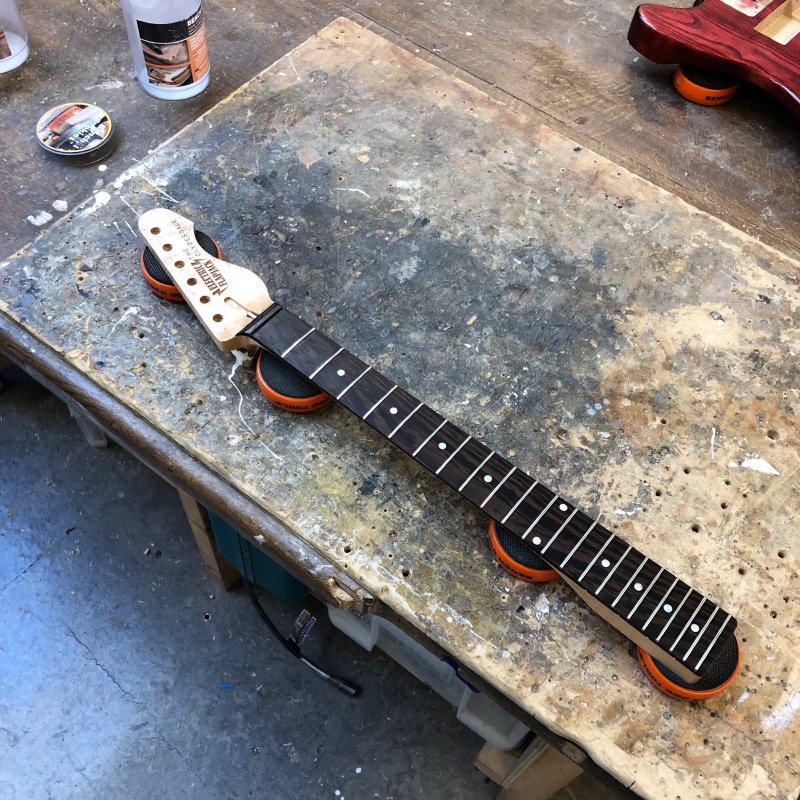
This let me get both the body and the neck finished before I went away, of this will have been curing in the mean time, so now I can go back and start the assembly this week. Before leaving for Rotterdam I ordered all the remaining parts for the guitar, so they should all have arrived by the start of the week. The only fabrication I need to do now is the cutting to the scratch plate, which I’ll touch on later in these notes.
Given The Clydesdale was at a slow stage where I can’t do much to it, I finally turned my attention back to The Prototype Offset. This guitar was “finished” a little while ago, but I had problems setting up the floating vibrato on it, I just couldn’t get it to stay in tune, and as such I felt I couldn’t ship it. I really should have dealt with this a while back, but with The Clydesdale being behind I wanted to focus on that first, and am only now getting around to it. There are unfortunately only so many hours in the day, and I can’t devote them all to guitars as I’d like.
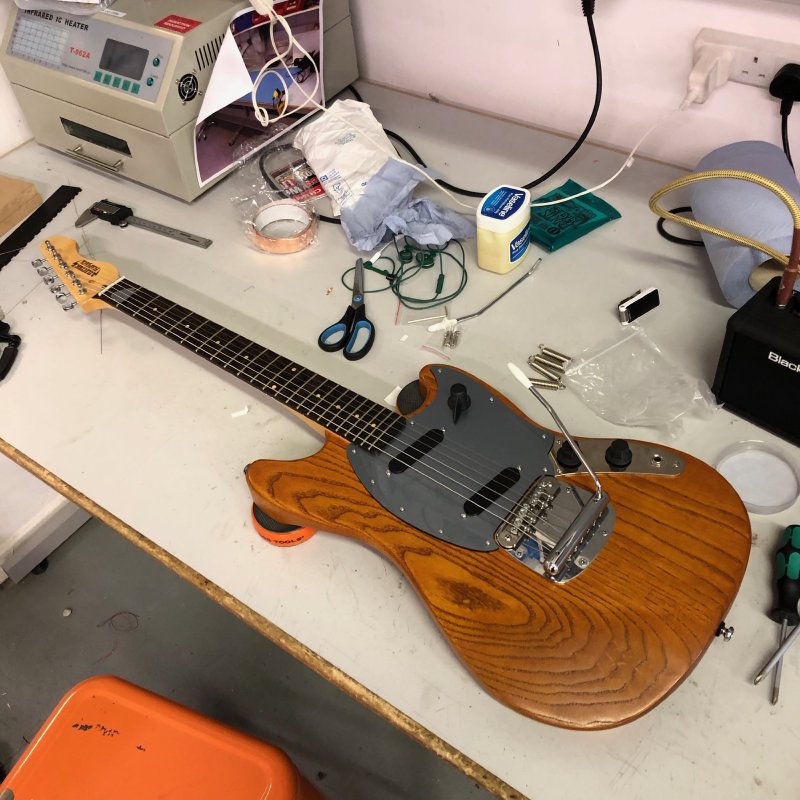
I sat down for an afternoon with the guitar, armed with some spare strings, some spare bridge springs (some tighter and some loser), and some vaseline to let me make sure everything was moving properly, and I tried to work out what was what. The first thing to eliminate was whether there was an internal interference that was causing the bridge to get stuck or struggle. The problem with the dynamic vibrato design found on the Fender Mustang (similarly the one on the Jaguar and Jazzmasters) is that you can’t see what’s going on inside once mounted (c.f, the unit on a Strat where you could see what’s going on easily). To get around this I constructed a bridge mount made in MDF that was the same thickness as the cavity I’d made in this guitar, which let me check if there was any contact as I operated the vibrato.
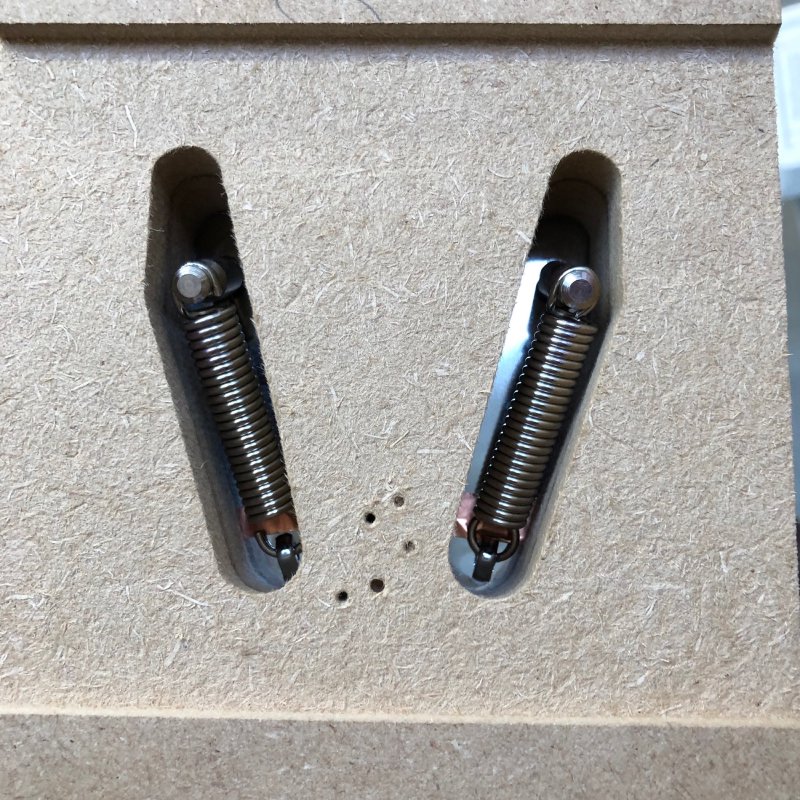
This told me quickly that this wasn’t the case: despite being close to the sides, they don’t touch at all, and nothing protruded out the bottom either, which was a relief as it meant I didn’t have to take a router to the guitar to remove some more wood.
But then the question is what was I doing wrong? The short version of a long story, which I will blog as a separate tutorial, is that two things needed correcting. Firstly, I’d not realised that for this vibrato design to work correctly I needed the posts that sit between the strings and the springs to be perpendicular to the body surface when everything is at rest and in tune. Once I realised this, it was much easier to see the impact of tweaks to things like the height of the string mount point on these posts and similarly for the springs, as you could use the angle of the posts as an indicator as how well or badly it was set up.
The all highlighted the second issue, which was that the springs I had were too tight for the strings I was using (11s), and when in tune the bridge was far from it’s optimal position. Thus I swapped the springs for a lighter pair, and switched the strings back to a slightly lighter gauge, and now the guitar is much happier. It’s still not perfect, but definitely stays closer to in-tune after you use the vibrato. Here’s a little vid of me playing the guitar (admittedly not with vibrato, as I was just having fun here and I don’t really know any songs that use the vibrato).
It’s been quite an educational experience working through this, and I’m amazed that floating bridges are as popular as they are given how balanced they need to be. Expect a proper write-up with pictures in the near future.
The one thing I did realise coming back to this guitar after a couple of months away is that I’m not happy with the scratch plate, which was laser cut from acrylic due to the failed attempt at making it in PVC (as documented here). I’ve decided to have another go at making PVC scratch plates on the CNC router, both for this and for The Clydesdale. My plan to overcome the wrapping that PVC naturally does is to use double sided sticky tape (and lots of it) to tape the PVC flat (in addition to screwing it down to stop side motion when being cut). Hopefully this will produce a better result than last time.
After getting more quotes for the metal part for the pedalboard I pulled the trigger on getting a prototype commissioned. In the end I had two quotes at roughly the same price, but I went with the supplier who was more local and would do powder coating as an option, but with a higher lead time. I think right now I just want to optimise for somewhere I can easily go talk to the people if things don’t work out as I hope: this being my first attempt to get metal fabricated I’m sure something will go wrong as I’ve not designed it right or communicated it correctly.
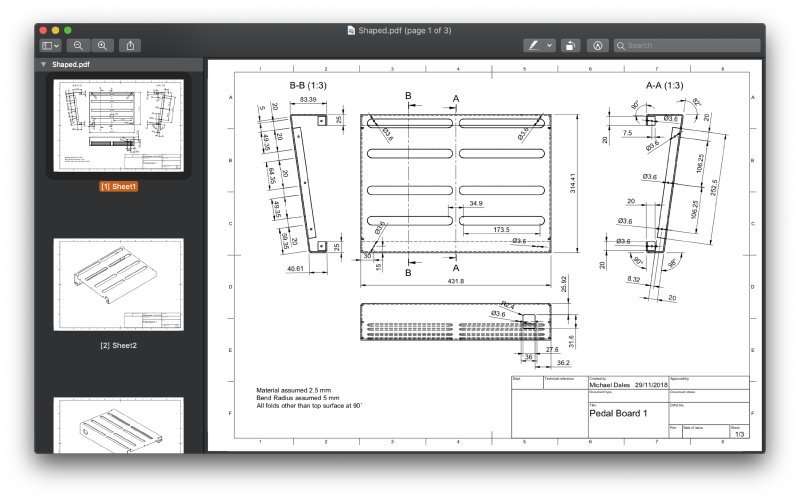
I suspect I’ll get the first prototype back in January, which is quite exciting.
For most of this week my other half was attending a conference in Rotterdam, and having never been to that part of the world I tagged along. Given I’d be at a loose end for much of the time, and the weather forecast was poor, I took advantage of the fact we were travelling on the Eurostar rather than flying and took my guitar with me, so I could keep up my regular practice routine in the AirBNB each day.
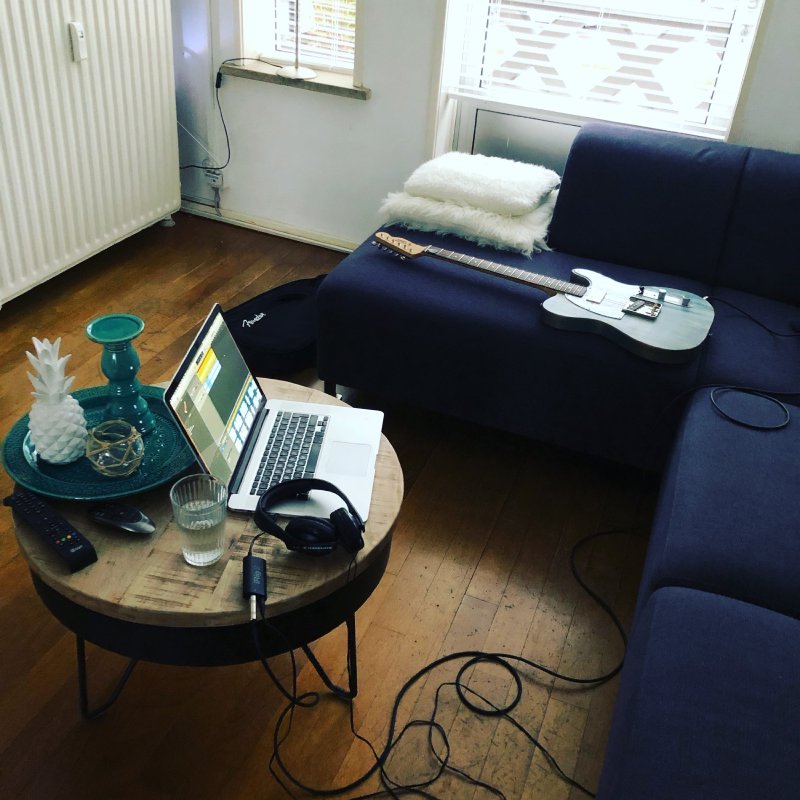
I was using Garageband on my Mac via an iRig adapter to let me get sound without annoying the neighbours, and it was fun to try and actually record some songs along to a virtual drummer - mostly a reminder that I don’t do that often and as such my timing needs a lot of work :) But that’s inspired me to do more of that, and ideally do so with my mic’d up amp and pedal board.